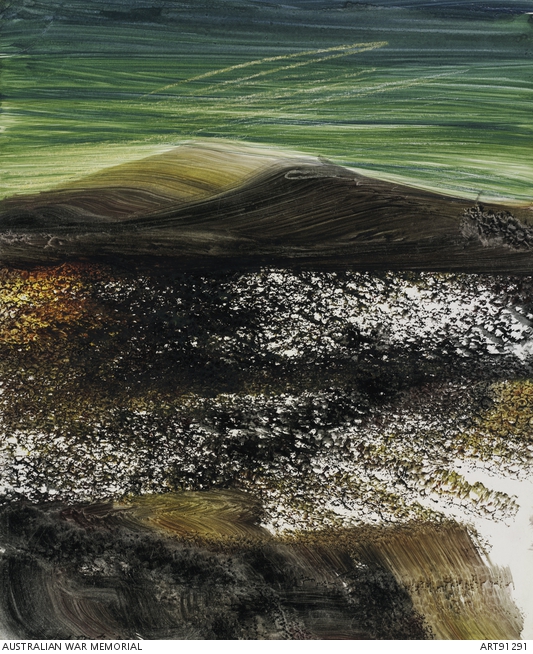Sidney Nolan: the Gallipoli series - Themes
Origins
In 1955 Nolan and his wife, Cynthia, moved to the Greek island of Hydra at the invitation of George Johnston and Charmian Clift. Inspired by his reading of Robert Graves’s The Greek myths, and Homer’s Iliad, Nolan began work on a Trojan War series. At Johnston’s urging, he read Alan Moorehead’s New Yorker article which discussed the geographical proximity of Gallipoli and Troy and the similarities between these two famous campaigns. As it happened, Moorehead was then also living nearby, on the island of Spetsae, completing what would become his best-selling book on the Gallipoli campaign.
Meanwhile, Nolan’s own research had led him to the archaeological museum in Athens, where he became fascinated by classical sculpture and the depiction of ancient Greek warriors on vases. Around this time he also briefly visited Gallipoli and the site of ancient Troy. Little wonder that Nolan soon began to explore the connections between Troy and Gallipoli in his art.
The Landscape
The paintings in Nolan’s Gallipoli series depict landscapes that are a fusion of both the real and the imaginary. The landscape that Nolan would have seen when he visited Gallipoli was dominated by an impenetrable growth of thorny shrubs, similar to what visitors can see today. Then and now, the dry escarpments above ANZAC Cove are much as they were in 1915, and from Chunuk Bair, the undulating ridges and gullies unfold themselves. But Nolan’s landscapes are also poetic evocations, a lament for a place where so many lives were lost.
Nolan’s passion for landscape painting had begun during his military service in Western Victoria. There the endless blue sky and the rolling wheat fields provided him with a new artistic genre to explore and new forms to develop.
His interpretive approach to landscape continued to evolve while working on the Gallipoli series. His discovery of a German textile dye allowed him to experiment and create barren and scarred landscapes on 12 x 10-inch coated art paper. Sheet after sheet would be covered using textile dyes and wax crayons. Often the nature of the materials themselves would lead to a change of style and technique.
Battle
Nolan’s reading of classical Greek literature inspired his depiction of Australian soldiers as “reincarnations of the ancient Trojan heroes of mythical times”. His paintings and drawings of the Australians on Gallipoli recall the images of Greek heroes, who are shown fighting naked and without their armour on vases of the classical period. Inspired by these powerful, physical figures, Nolan depicts the modern soldier as someone caught up in a bloody and violent war.
Artillery fire became a deadly part of the ANZACs’ daily lives on Gallipoli. But Nolan saw a terrible beauty in the bursting shells; he depicts them as figures that slide across the surface of the paper in almost balletic formations.
The Sea
Nolan’s images were often inspired by the photographs that he knew from The ANZAC book, and those he viewed at the Imperial War Museum in London. Many of the photographs depicted soldiers bathing, or working and relaxing in and around the shore.
A sense of the sea pervades the campaign, whose very goal was to seize control of the Dardanelles, the narrow stretch of water that separated Gallipoli and Troy. The Australians who clambered ashore on 25 April 1915 at what came to be known as ANZAC Cove would sometimes return to swim in its waters. To escape the grime, the filth, and the vermin of the trenches, they were willing to brave the Turkish shrapnel that occasionally spattered the beach.
Many of Nolan’s ideas about war and death came together in the Gallipoli diptych, a major work whose water imagery alludes to the risk of drowning. When the painting was exhibited, one critic praised the work for showing how “flesh and blood soldiers, the real overlapping the mythical, the strong holding the weak, sink or swim towards inevitable destruction”.
Australian Identity
Nolan’s Gallipoli portraits represent an attempt to define the Australian national character. They provide timeless images of the ANZACs: the young and the old, the innocent and the war-weary, the bushman and the city-dweller.
Nolan’s early portraits in the Gallipoli series, such as Kenneth and Soldier, Arthur Boyd, are of imposing figures. In their slouch hats and emu plumes, these men give off a sense of bravado. A degree of optimism about the war and its outcome can be in their faces, drawn in bold washes of brown and green. In contrast, the later portraits were painted in lurid colours which accentuated the trauma of battle. These young soldiers have distorted faces, their eyes shaded or blood-shot, and they are disengaged and distant.
The portraits chart Nolan’s 20-year struggle to create a visual language with which to express the Gallipoli tragedy. Even in 1978 he still talked about painting more images as he felt he had not thoroughly explored this momentous event in Australia’s history. Instead, other ventures and travels drew him away and he never returned to the Gallipoli story.



















